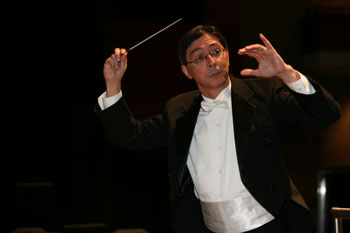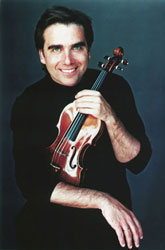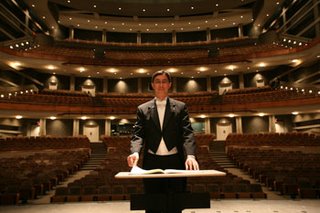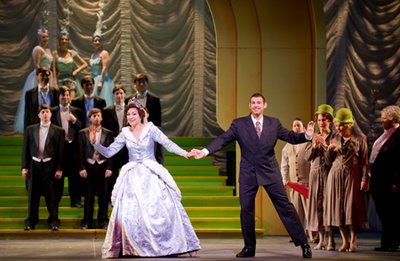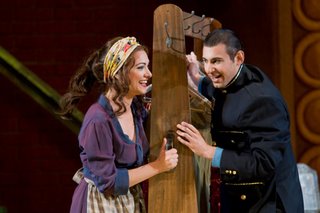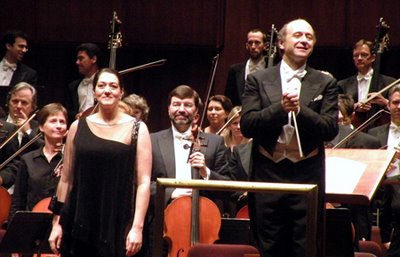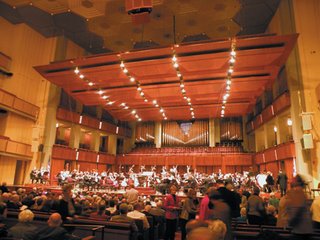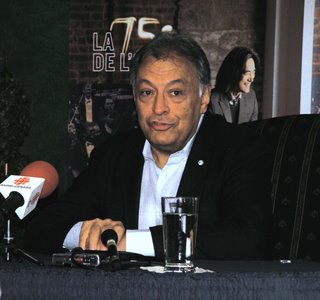Met in HD: Berlioz' Damnation of Faust Lepage-d!
THIS WEEK IN TEXAS
I learned about opera watching Herman Geiger-Torel build the Canadian Opera Company in
Again, speaking personally, the future of opera began to look a whole lot brighter when I saw the productions Herbert von Karajan was presenting in Salzburg in collaboration with Gunther Schneider-Siemssen in the late 1960s and early 70s. Here was a fresh approach to a decaying art form, making use of the latest technology. Futuristic and abstract sets, complex lighting schemes and elaborate projections brought a new dimension to Wagner’s Ring cycle.
The Karajan-Schneider-Siemssen Ring was eventually brought to the Met and it was my good fortune to get to know Erwin Feher, the technical genius who adapted this production to the Met’s quite different stage and equipment.
This long introduction is my way of introducing a review of the Met’s current production of Berlioz’ La Damnation de Faust in its Met HD Live incarnation last week. I am all in favour of applying the latest in stage and film technology to operatic production; however, I reserve the right to object when a director turns a masterpiece into a farce. I am afraid Robert Lepage managed to do just that with Berlioz’ légende dramatique. Perhaps it was the parade of soldiers walking backwards during the “Hungarian March,” or the lines of naked men inhabiting the bowels of hell – who knew that hell was a gay bathhouse? – that did it for me. But let me start with the overall concept. More details later.
La Damnation de Faust is not an opera at all. It works perfectly well as Berlioz intended, as a concert piece. Had he wanted to turn it into an opera, he would have done so himself and most certainly would have made lots of changes in the process.
I find the whole concept offensive. To convince me otherwise will require a production far more persuasive than the incoherent mess Le Page perpetrated on the stage of the Met. Lepage has talked a great deal about how he has brought “state of the art video techniques” to this work. Mention was made of “interactive video” in which the singers can change the images simply by moving their bodies. I noticed that Lepage talked much less about any connection between the images and movements he used, and the music. My impression is that the music was simply one of many components used to heighten the theatrical experience. Think Cirque du Soleil. By the way, Lepage created a show called KA for Cirque du Soleil at the MGM Grand in Las Vegas in 2005.
For La Damnation de Faust, Lepage created a huge four-story scaffolding and virtually all the action in the production takes place in some part of this structure. As set design, think the TV quiz show Hollywood Squares with each of the celebrity panelists occupying a different cell in the scaffolding matrix. At times, Lepage did indeed have characters occupying these cells, and at other times either cellular projections or integrated projections. One could understand the fun Lepage had in organizing these cells and projections, but clearly he ran out of both money and ideas. While Cirque du Soleil can easily find $32 million for a Las Vegas show, the Met would have trouble raising one-tenth of that for a single production. Nor could they find the time required for weeks of technical rehearsals.
It appears that Lepage is a director who proceeds by free association, rather than by studying the work he is engaged to produce. I am still trying to figure out why Faust was unceremoniously dumped out of a boat – why was he in the boat in the first place? – then seen to be swimming or tumbling under water along with some unidentified other folks. Later, during the scene in which spirits are apparently bewitching the sleeping Marguerite we see eight ballet dancers in separate cells in the scaffolding doing nothing more interesting than what appear to be basic warm-up exercises at the barre. The ‘climax’ of this engrossing tableau comes when a group of half-naked men attached to cables begin climbing up and down the various levels of the scaffolding. This development combined elements of Cirque du Soleil, Chippendales and Monty Python.
The “Ride to the Abyss” was one of Lepage’s great set pieces. He put together images of galloping horses and menacing birds with riders in silhouette. Unfortunately, none of the riders were either Faust or Méphistophélès, who were content to stand nearby and deliver Berlioz’ music as best they could. Then came another Faust-dump, this time into the bowels of hell and the eager arms of the Chippendales lads looking surprisingly buff and content in their new digs. The coup de théâtre was to have Marguerite ascend into heaven by way of an enormous ladder in the middle of the stage. It was all very silly and ultimately ridiculous.
And the music? Susan Graham as Marguerite and John Relyea as Méphistophélès were excellent in spite of the appalling production thrust upon them. Marcello Giordani is turning into the ‘go-to’ guy among tenors at the Met. He seems to be involved in nearly every production. In fact, on the day of this Damnation de Faust he also replaced an indisposed colleague for the evening performance of Madama Butterfly. I would like to be able to say that he sang beautifully as Faust, but alas, he didn’t. He sang sharp from almost beginning to end. I think the poor man deserves a rest. James Levine was in the pit. I have to wonder about his judgement as music director in allowing such a travesty to go forward, let alone having to look at it every time he conducted it. Perhaps that explains why he took the “Hungarian March” at such an absurdly fast tempo. No doubt he had a car waiting.
There is, of course, another way of looking at this farrago. Lepage himself has suggested that La Damnation de Faust was merely a dry run for some of the technology he is planning to use for the new Ring cycle at the Met in the fall of 2010. If so, there is still time for General Manager Peter Gelb to retract his conviction that “Lepage represents everything I believe in regarding storytelling and visual presentation.”
Lepage may be a creative genius with his own multidisciplinary production company Ex Machina or in Las Vegas, but he is out of his comfort zone in an opera house. And to hand him carte blanche with the greatest work in operatic literature is foolish and irresponsible.
For the record, at the theater I attended in
Paul E. Robinson is the author of Herbert von Karajan: the Maestro as Superstar and Sir Georg Solti: his Life and Music, both available at http://www.amazon.com/. For more about Paul E. Robinson please visit his website.
Labels: classical music, conductors, James Levine, John Relyea, Marcello Giordani, Met in HD, opera, Robert Lepage, Susan Graham


